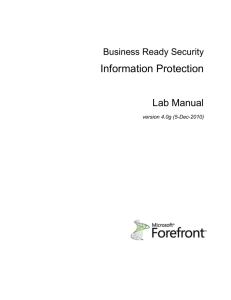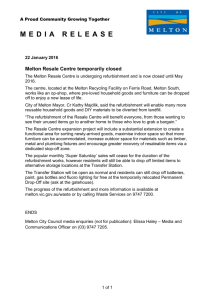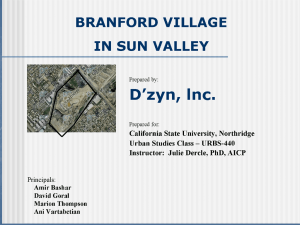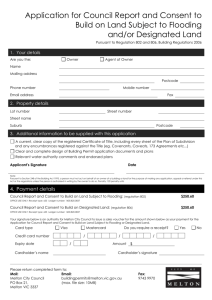3 Strategic Planning Framework
advertisement
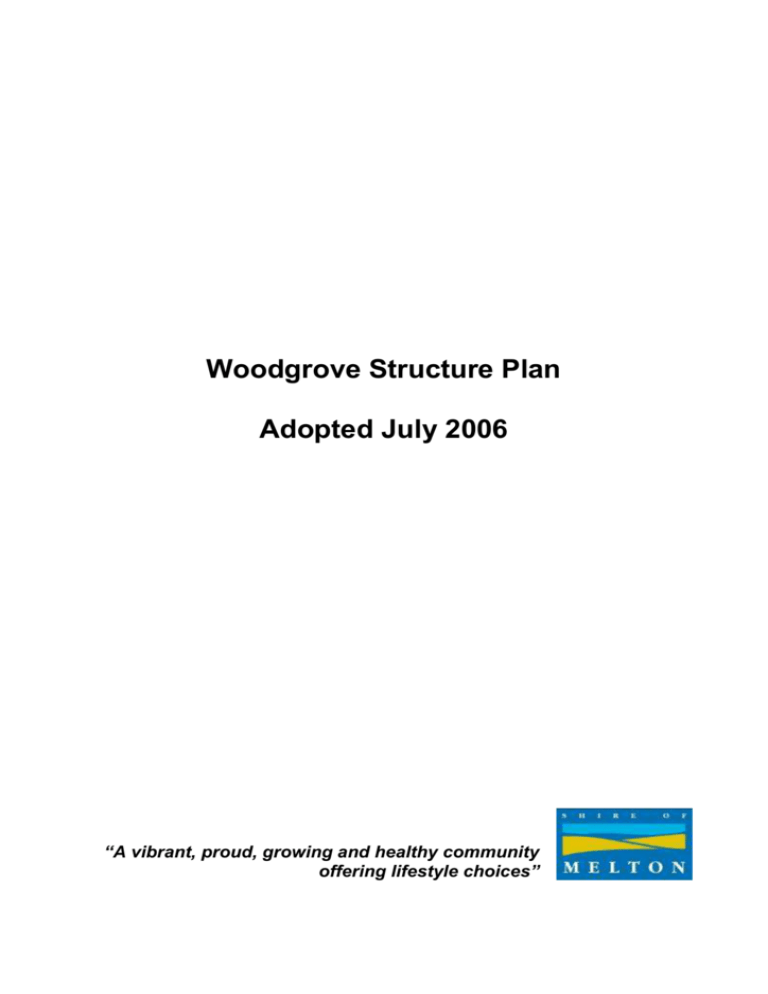
Woodgrove Structure Plan Adopted July 2006 “A vibrant, proud, growing and healthy community offering lifestyle choices” TABLE OF CONTENTS Chapter / Section Page No. 1 INTRODUCTION 3 1.1 1.2 Background .........................................................................................................................................3 Study Objectives .................................................................................................................................5 2 PRINCIPAL FINDINGS 2.1 2.2 2.3 2.4 2.5 2.6 2.7 Housing Development and Population Growth ................................................................................6 Centre Setting and Built Form............................................................................................................6 Centre Activities ..................................................................................................................................9 Patronage Behaviour ..........................................................................................................................9 Role and Function ............................................................................................................................ 10 Access and Car Parking .................................................................................................................. 10 Summary .......................................................................................................................................... 11 3 STRATEGIC PLANNING FRAMEWORK 3.1 3.2 3.3 3.4 3.5 Framework Structure ....................................................................................................................... 13 Vision Statement .............................................................................................................................. 13 Context statement ............................................................................................................................ 15 Recommended Strategy ................................................................................................................. 16 Recommended Implementation Strategy ...................................................................................... 24 6 13 TABLES Table 1 Woodgrove Floorspace Distribution................................................................................................9 FIGURES Figure 1 - Functional Analysys ......................................................................................................................8 Figure 2 - Planning Evaluation ................................................................................................................... 12 Figure 3 - Strategic Planning Framework.................................................................................................. 14 Figure 4 - Development Framework .......................................................................................................... 23 Ratio Consultants Pty Ltd ii Woodgrove Major Activity Centre Structure Plan –Final Report 1 INTRODUCTION 1.1 BACKGROUND Melton Township is situated approximately 35km west of central Melbourne, and separated by some 10km of ‘green wedge’ land from Melbourne’s main urban area (defined by the UGB). Woodgrove Activity Centre – which includes Woodgrove and Coburn Central and nearby shops - is the second most important community destination in Melton after the Melton Shopping Business District (SBD) on High Street. Woodgrove is approximately 2km west of the SBD, on the corner of High Street and Coburns Road. The existing buildings and a large area of car parking cover roughly one third of an otherwise vacant 35 hectare site. Woodgrove has been classified as a Major Activity Centre in Melbourne 2030; the State Government’s planning strategy for greater Melbourne. Major Activity Centres require Structure Plans to guide their future use and development. Ratio Consultants and associated consultants were engaged by Melton Shire Council to produce three plans for Melton, the third of which is this Structure Plan for the Woodgrove Activity Centre. Following several rounds of consultation and surveying of relevant stakeholders, the Structure Plan has been developed. The Structure Plan sets out the vision and the guidelines for the future expansion of the centre and the gradual redevelopment of existing features which could be improved for the benefit of many centre users. Physical Context Woodgrove is a well-patronised shopping centre which provides a range of retail options for its shoppers. Vacancy rates are very low and the centre has expanded in recent years, gaining a cinema complex and additional shops. Melton’s population continues to increase, and the owners of Woodgrove intend to expand the centre considerably. The centre’s buildings are separated from the nearest housing by a large stretch consisting of wide roads – High Street and Coburns Road, buffer strips and car park. Travel to the centre other than by car is dangerous and unrewarding in terms of convenience and amenity, as very few elements of the outdoor surroundings of the centre have been designed with pedestrian, cyclist or public transport visitors in mind. Some public transport is available but it is currently far from being competitive with the car for most visitors. Within the centre, large car parks and access roads separate some groups of shops from one another, making it necessary for commuters to either walk or drive through car parks to access other shops within this centre. Pedestrians must generally walk on roads. Woodgrove’s main complex is similar to many late 20th century shopping centres in that it largely faces inwards, leaving concrete walls comprising the external edge. The blank areas of loading bays and other buildings also detract from the visitor’s experience. Besides the indoor areas of the shopping centre, almost no attractive public spaces are available. Woodgrove Activity Centre Structure Pl an 2006 3 Woodgrove Major Activity Centre Structure Plan –Final Report Policy Context Melbourne 2030, the Victorian Government’s metropolitan planning policy, defines a hierarchy of ‘Activity Centres’ and provides guidance for their redevelopment and expansion. The hierarchy has the Melbourne CBD at its top, followed by Principal Activity Centres (none of which are in Melton) and then Major Activity Centres. It designates both the Melton SBD and the Woodgrove/Coburn Central site as Major Activity Centres. It requires local municipalities to create a Structure Plan for each Major Activity Centre. It also provides the principles which Structure Plans will be based on. Direction 1 of Melbourne 2030 – “a more compact city” – envisages each Major Activity Centre being built up “as a focus for high-quality development, activity and living for the whole community” (DSE, 2002). Major Activity Centres which are currently dominated by shopping, such as Woodgrove, are encouraged to develop additional functions such as entertainment, professional services such as doctor’s surgeries, and passive recreation in public space. Central to this strategy is a desire to reduce the need to travel, especially by car, from one activity to another. It is important that these activities are clustered together in the Major Activity Centre and are easy to walk between. All these points are reiterated in the State Planning Policy Framework (SPPF) contained within Melton Shire’s Planning Scheme. Woodgrove should have a greater variety of uses in the future and continue to expand, but in a sustainable way. The extent to which Woodgrove is likely to expand will depend on future population levels, and the location of the Urban Growth Boundary around Melton is crucial in determining its future population. Melbourne 2030 also emphasises good urban design, focussing on the often neglected external surroundings of shopping malls. Design improvements for Woodgrove’s external areas have been considered with reference to Melbourne 2030’s first and fifth directions, which are again reiterated in the SPPF. Melbourne 2030 also endorses the improvement of public transport service to Activity Centres, and changes at Woodgrove can go some way towards this objective. Melbourne 2030 is echoed by the Outer Western Suburbs Transport Strategy (OWSTS) in this regard. This is the extent of relevance of the OWSTS - the projects planned in this strategy will not significantly affect Woodgrove. Melbourne 2030 also endorses improvements to walking and cycling networks at and between centres. All these objectives stem from a central principle of reducing car use. Woodgrove Activity Centre Structure Pl an 2006 4 Woodgrove Major Activity Centre Structure Plan –Final Report 1.2 STUDY OBJECTIVES The key objectives of the Woodgrove Activity Centre Structure Plan address the existing operation and characteristics of Woodgrove. The objectives ensure that Woodgrove adapts to meet the needs of its users well into the future. The Structure Plan will encourage the development of Woodgrove into a more attractive, more sustainable and safer place. The achievement of these goals will also ensure that Woodgrove contributes to the overall prosperity and vitality of Melton Township. Planning up to this stage has involved researching opportunities and constraints of the centre as it currently stands, and determining the factors which may cause it to change in the future. The plan then provides guidelines for future development on the site to steer development towards the best outcomes for the community. The overarching objectives for the structure plan are: expanding the mix of activities (retail, commercial and community) within the Woodgrove Activity Centre, to meet the needs of the broader community, improving the pedestrian network, especially around the external edge and through the car parks - to make the centre safer for pedestrians and accessible on foot or on bicycle from nearby houses, increasing the quality and number of outdoor public spaces, to facilitate passive recreation, improving vehicle and pedestrian access to and from the site with the provision of safe and appropriately designed intersection treatments at key locations. improving the experience for public transport users who stop at the centre, to encourage and reward public transport use, and organising and emphasising major entrances and circulation roads within the centre, and ensuring that these routes increase the safety of pedestrians. Woodgrove Activity Centre Structure Pl an 2006 5 Woodgrove Major Activity Centre Structure Plan –Final Report 2 PRINCIPAL FINDINGS 2.1 HOUSING DEVELOPMENT AND POPULATION GROWTH The form and structure of a shopping precinct is highly dependent upon the characteristics and size of its catchment population. In recent years Melton Township has experienced significant residential growth. At the 2001 Census Melton had a total population of 33,400 persons. The population projections formulated by the State Government (DSE, 2004) estimate that the population of the Melton Balance Statistical Local Area (SLA) is likely to rise to approximately 106,552 persons by 2031. This is approximately three times the 2001 Census population. The significant growth that is predicted to occur will have substantial impacts on the future retail requirements of the township. On the 28 November 2005 the State Government introduced an amended urban growth boundary into the Melton Planning Scheme. Movement of the urban growth boundary substantially increased the growth potential of the township. The amended UGB provides the potential for the following household increases by 2030: - Melton Township North – 950 households - Melton Township South – 4,600 households - Toolern – 13,000 households (Total additional households – 18,550 – Based on DSE lot yield calculations). These households would be in addition to the existing and proposed 20,000 households already approved /developed within the previous UGB for the Township. This potential growth to the catchment of Woodgrove will see the centre expand, in terms of both function and size. 2.2 CENTRE SETTING AND BUILT FORM Coburn Central and Woodgrove are two adjacent but unconnected shopping malls located within the Woodgrove Activity Centre. They are located on the corner of High Street and Coburns Road, approximately 2km west of the Melton Shopping Business District. The eastern boundary, Coburns Road, acts as an interface between residential areas and the commercial activity located at Woodgrove; while transition between Melton Secondary College and Woodgrove occurs across High Street and a median strip. The Western Freeway is located to the south of the centre and a substantial amount of open space is located to the west. Woodgrove Shopping Centre’s tenants include retail anchors such as Kmart, Coles and a five-screen cinema. These buildings have relatively blank facades and are mostly surrounded by car parks. The car parks are quite vast, and prevent safe and convenient access to other buildings. Woodgrove Activity Centre Structure Pl an 2006 6 Woodgrove Major Activity Centre Structure Plan –Final Report The centre’s Western Freeway frontage has a broad landscape buffer, which is an appropriate interface for such a road. This area offers an opportunity to increase the level of amenity – additional landscaping within this space would significantly enhance the attractiveness of the buffer area. A service station and fast food restaurants address the Coburns Road frontage of the site. The shopfront environment of this centre is generally of a low quality with relatively blank facades, typical of larger retail formats. Figure 1 (overleaf) indicates the important elements and functionality within the centre. Although activity in the area is spread between the two enclosed centres, the fast food restaurants and services on the southeastern corner of the site, it is likely to be increased further by the proposed development of bulky goods stores south of the site and development of a health precinct in the west. In addition to the expanding retail centre these developments also offer the opportunity to improve the existing levels of accessibility and integration within the centre. The additional infrastructure required for these developments should be planned and managed so as to improve the existing pedestrian amenity, public transport movements and facilities (i.e. location of bus stops, designated public transport interchange, seating and shelter amenities). Woodgrove Activity Centre Structure Pl an 2006 7 Woodgrove Major Activity Centre Structure Plan –Final Report FIGURE 1 - FUNCTIONAL ANALYSYS 2.3 Woodgrove Activity Centre Structure Pl an 2006 8 Woodgrove Major Activity Centre Structure Plan –Final Report 2.3 CENTRE ACTIVITIES A Coles Supermarket and Kmart anchor Woodgrove shopping centre. There is also a cinema complex at the western end of the centre. The remainder of the tenancies are predominantly occupied by retail goods. TABLE 1 WOODGROVE FLOORSPACE DISTRIBUTION Category Floorspace (GLA) Retail Goods 18,527 m² Retail Services 757 m² Professional and Commercial Services 2,809 m² Vacant 307m² Total 22,400m² Source: Ratio Consultants, 2004 The table illustrates the following important points regarding the existing retail provision in Woodgrove. Within the category of Retail goods, 29% of the floorspace at Woodgrove is dedicated to Food, Groceries and Liquor stores; the majority of which is within the Coles Supermarket. 42% of floorspace is dedicated to Department and General stores; the main tenant in this category is Kmart, and it is supplemented by The Reject Shop and Best and Less. 13% of floorspace is occupied by clothing, footwear and fabric stores, and 12% other household goods stores. The remaining 4% is occupied by retail services; the largest of these are Video Busters and Australia Post. The centre has a very low vacancy rate (less than 1%). Coburn Central is anchored by Safeway; the subsidiary tenants include a bakery and several other food retailers. 2.4 PATRONAGE BEHAVIOUR Woodgrove is the most popular destination for grocery shopping in Melton; 59% of those surveyed indicated they mainly visit Woodgrove for this purpose (Sweeney Research; p23). The convenience nature of Woodgrove is further illustrated by the destinations cited for ‘special item’ shopping; only 24% cited Woodgrove compared to 31% for High Street. Special items are defined as shopping other than grocery or day-to-day shopping and generally described as higher order retail goods. The survey also asked respondents to rate Woodgrove centre as a place to shop. 67% rated it either good or very good and 4% poor. The remainder rated it satisfactory. This result is favourable compared with High Street. The most prolific suggestions for improvements to Woodgrove comprised ‘more variety,’ with a further 15% citing ‘more shops.’ Woodgrove Activity Centre Structure Pl an 2006 9 Woodgrove Major Activity Centre Structure Plan –Final Report These results indicate that Woodgrove is used primarily for convenience shopping (rather than comparison) and that most people who currently use the centre favour its expansion in order to offer a wider variety of services. 2.5 ROLE AND FUNCTION The regional role fulfilled by Woodgrove is apparent given the tenancies, layout and visitation patterns of the centre. It is the second largest retail concentration in the Melton Township, however the lack of many services critical for a community centre has created a single function centre. While it serves this grocery shopping function well, in light of the centre’s designation as a Major Activity Centre in Melbourne 2030, the centre should strive to act as a multi-function centre, offering a wide variety of activities and services in a pleasant and vibrant environment. Future developments will offer an opportunity to achieve this. The development of the super clinic (Department of Human Services), private medical facility, community health centre and proposed Council Youth facility (in close proximity to these health facilities), will see the establishment of a health and well being precinct. This precinct will strengthen Woodgrove’s role as a Major Activity Centre, providing a diverse range of services and facilities beyond a solely retail centre. 2.6 ACCESS AND CAR PARKING The local bus network links the centre to the High Street Shopping Business District and the Melton Railway Station. Bus stops are provided within the centre towards its northwest corner, however they are located alongside a footpath which links car parking areas and entrances to the shopping centre. Consequently, the shared nature of this space is likely to reduce the efficient use of it for both activities, and is an impediment to the increased use of public transport. The construction of a new bus interchange offers an opportunity to improve the local environment for both these groups of visitors. Pedestrian access via footpaths does not provide a direct, comfortable or attractive route between the buildings or to them from the surrounding car parks. The link between the two shopping centres traverses a loading area, and pedestrian access to external buildings, including Centrelink, Blockbuster Video and the fast food restaurants requires travel across car parks and is consequently interrupted by vehicular movements. Footpaths are often located alongside inactive frontages, creating poor pedestrian amenity and safety. Pedestrian amenity within the shopping centres varies somewhat. Woodgrove shopping centre offers pedestrians an attractive and inviting environment. It is well lit, particularly using natural light, and the shopfront environment is continually active. Coburn Central also has continuous active frontages; however the environment is not as attractive, and appears aged when compared to Woodgrove. Parking is generously provided, consistent with the car-based nature of the precinct; 96% of visitors travelled by car to Woodgrove, compared with 85% for High street and Melton South The majority of parking areas are poorly landscaped and generally contribute to a sense of vastness. In particular, the High Street frontage is occupied by a large open-air car park, which presents an unattractive interface to the passing traffic and housing opposite. Woodgrove Activity Centre Structure Pl an 2006 10 Woodgrove Major Activity Centre Structure Plan –Final Report The residential areas to the north of the site are separated from the centre by busy High Street and associated median strips which comprise a combination of gravel, trees and shrubs. There are no traffic lights or pedestrian crossings and this prevents safe pedestrian movement between the residential areas and the centre. It is important for pedestrians, in particular, to have access to services within the centre in a safe manner and to experience a high level of amenity whilst doing so. 2.7 SUMMARY The Planning Evaluation map (overleaf, Figure 2) indicates the key issues that have been raised through the principal findings. There are several key characteristics, which contribute to the current role and function of the centre. High quality pedestrian access throughout the centre is of prime importance; currently it is disintegrated, unattractive and, in some areas, dangerous. Other access issues include the level of amenity in the car parks, and that surrounding the bus stops. The inadequacy of the current bus stop area strongly supports the need for a new and improved bus interchange to be developed as part of the future expansion of the centre. The centre currently operates as a convenience shopping location, and the lack of diversity in services and activity means that the centre currently does not fulfil a key requirement. Woodgrove Activity Centre Structure Pl an 2006 11 Woodgrove Major Activity Centre Structure Plan –Final Report FIGURE 2 - PLANNING EVALUATION Woodgrove Activity Centre Structure Pl an 2006 12 Woodgrove Major Activity Centre Structure Plan –Final Report 3 STRATEGIC PLANNING FRAMEWORK 3.1 FRAMEWORK STRUCTURE The form of the recommended Strategic Planning Framework to guide the long term planning and development of Woodgrove is set out in Figure 3 (overleaf). It comprises: A vision statement for the future planning of the town centre A context statement that sets out the planning problem and parameters for development in Woodgrove The recommended strategy for the town centre, comprising: 3.2 Planning objectives for Woodgrove Strategic Principles for land use and development Urban design principles Key elements of the plan Recommended implementation strategy and framework for the town centre, comprising: Zoning amendments to the planning scheme A monitoring and review program for the Structure Plan VISION STATEMENT Several rounds of consultation were undertaken in order to understand the perceptions and issues important to Melton. The responses from this consultation have informed the vision statement for Woodgrove. The ‘country town’ feel of Melton is a highly valued asset that should be reinforced through planning and development of Woodgrove. While most residents perceive the centre as being a good or very good place to shop, Woodgrove’s highway-focussed location has led to its development being largely car based, and consequently, pedestrian amenity within the centre is generally low. Given the projected increases in population that are forecast to occur in Melton, and the consequent increases to the catchment area of Woodgrove, it is anticipated that the centre will experience substantial expansion. The anticipated expansion of Woodgrove Activity Centre provides a unique opportunity to enhance visitor amenity to the centre. By directing new development in a way which improves the existing environment, combined with an increase in the range of uses, activities and public transport accessibility, Woodgrove will become a vibrant, interesting and integrated centre for those who shop, visit and work in the centre. Woodgrove Activity Centre Structure Pl an 2006 13 Woodgrove Major Activity Centre Structure Plan –Final Report FIGURE 3 - STRATEGIC PLANNING FRAMEWORK Woodgrove Activity Centre Structure Pl an 2006 14 Woodgrove Major Activity Centre Structure Plan –Final Report 3.3 CONTEXT STATEMENT 3.3.1 Legacy and attributes Melton was established as a satellite city and its growth has occurred in various stages since then. Woodgrove is a relatively modern shopping centre; Coburn Central is slightly older and significantly smaller. The modern architectural style of Woodgrove is attractive to many users; as such it is a popular grocery shopping destination. These two centres are located adjacent to each other, but are unconnected. They form the anchors at Woodgrove, and are supplemented by several fast food restaurants, a Centrelink office and a video store. Over time, a number of additional shops and services have located at the Woodgrove site and these have developed in a manner which exacerbated existing issues regarding access and amenity. Each of these external buildings has a separate, self contained parking area, which detracts from the integration and sense of place for the centre as a whole, particularly for pedestrian movement. In summary, the relatively modern Woodgrove centre has been the catalyst for recent development. Further, future development presents opportunities for the improvement of substandard legacies of past development. 3.3.2 Future growth requirements As Melton’s population continues to grow, the demand for retail and associated services and facilities will also expand. In order to meet this demand, further activities will need to be accommodated in the Shire’s activity centres. In particular, the development of a health precinct west of the current centre, provision of an adjacent community facility (Council’s Youth facility) as well as a bulky goods centre to the south will assist in the transformation of the centre into a true regional hub. It is also desirable that an expansion of the entertainment facilities offered in the centre occurs in order to consolidate the existing cinema and restaurant. It is imperative that the expansion of the Activity Centre incorporate the effective movement of public transport into the proposed road work network of the centre and importantly the provision of safe and convenient bus stops and location of a well designed bus interchange at strategic locations. Woodgrove Activity Centre Structure Pl an 2006 15 Woodgrove Major Activity Centre Structure Plan –Final Report 3.3.3 Managing growth The challenge of an effective strategy is to manage future growth so that the benefits of an increased range of activities and services are consolidated through improvements to user amenity. In particular, the strategy should seek to consolidate the existing layout in a way which enhances the sense of place experienced when visiting the centre. As the centre currently has little defining characteristic or central place, the expansion of the centre should focus on providing these elements. This, combined with enhancement of the existing pedestrian environment through the provision of a network of pathways through the centre, location of a strategically located and well designed bus interchange and development of a road network which enables the efficient movement of public transport will increase overall amenity and useability within the centre. Further, in order for the centre to provide for a range of access modes, it is important that the facilities for public transport are upgraded (seating and shelters and clearly defined bus stops in accessible locations). As development proceeds a number of road intersection treatments will need to be provided with existing intersections either consolidated or upgraded. The strategy recommends a number of intersection improvements to be triggered at particular stages of the development/expansion of the centre. 3.4 RECOMMENDED STRATEGY 3.4.1 Planning Objectives The planning objectives of this strategy are listed in the Introduction. They are repeated here in full. The objectives are: 3.4.2 expanding the mix of activities (retail, commercial and community) within the Woodgrove Activity Centre, to meet the needs of the broader community, improving the pedestrian network, especially around the external edge and through the car parks - to make the centre safer for pedestrians and accessible on foot or on bicycle from nearby houses, increasing the quality and number of publicly accessible outdoor spaces, to facilitate passive recreation, improving vehicle and pedestrian access to and from the site with the provision of safe and appropriately designed intersection treatments at key locations. improving the experience for public transport users who stop at the centre, to encourage and reward public transport use, and organising and emphasising major entrances and circulation roads within the centre, and ensuring that these routes increase the safety of pedestrians. Strategic principles for land use and development Woodgrove’s layout and design will be guided by the following strategic principles. Centre services planning Woodgrove Activity Centre Structure Pl an 2006 16 Woodgrove Major Activity Centre Structure Plan –Final Report The range of activities the Centre offers is critical for its future success as an Activity Centre. The expansion of the centre should be founded on the following principles: the range of activities available at the Centre should be wide-ranging and include community and professional services tenants, the Centre should offer comparison, as well as convenience shopping services, expansion in the range of services offered should be organised into precincts such as health, community facilities, entertainment and bulky goods. Council’s community facility (Youth Centre) must have direct road frontage and be located adjacent the health precinct and accessible public transport. Pedestrian network and movement The movement system is an important part of the Centre’s amenity and safety. It should be developed around the following guidelines: active or attractive building edges be abutted by attractive and clearly defined footpaths, wider footpaths outside active frontages and on main pedestrian routes, complete pathways from centre to margins and between buildings, especially to High Street and Coburns Road, and connecting Coburn Central and Woodgrove Shopping Centres with one another, new pedestrian traffic signals to allow crossing of the above arterial roads, raised and signposted zebra crossings at major crossings of internal access roads, with alternative crossing treatments at other points, if appropriate; and all crossings of loading bays are also to be raised. Access and circulation Improvements to existing and development of proposed intersection treatments at strategic locations, to be undertaken at key stages of the development the clarification of main access routes through carparks for cars and buses, with attention to crossings of pedestrian walkways, and see urban design (below) regarding entrances. Intersection and roadwork treatments − Intersection treatments will overtime be either improved or created to service the future expansion of the centre. − Offsite road an intersection works will need to be negotiated as part of a separate agreement with the owners and operators of the site. − Internal road works will be fully constructed by the developers, and will be identified as part of the detailed planning for future stages of development. Woodgrove Activity Centre Structure Pl an 2006 17 Woodgrove Major Activity Centre Structure Plan –Final Report Public transport accessibility buses to make use of new circulation layout, additional stops in strategic locations, related to directions of centre expansion, and, Development of a well designed bus interchange (incorporating shelters, seating and clear signage) to be provided at an accessible and safe location. Publicly accessible space The existing public spaces should be improved, and further spaces developed, using the following principles: 3.4.3 embrace the concept of active edges, which increase activity and safety outside the buildings as in a conventional street shopping centre, loading bays should, where possible, be designed to have smaller entrances and be largely hidden from public view, providing greater outdoor areas, with ample seating and shade, encourages the development of a sense of place and community, and may also encourage walking as a means of access to the site, and continued use of public spaces also increases safety in and around these spaces, and are also a critical component of a ‘healthy’ environment. Staging The proposed expansion of the Woodgrove Activity Centre is planned to occur in three stages over the next 10-12 years. The first stage of development is nearing completion, whilst the second and third stages will be progressively designed and developed up to around 2016, dependant upon market trends. Stage 1 Stage 1 of the development is nearing completion, and comprises: - Current combined retail floorspace of the Woodgrove and Coburn Central centres. - Construction of the first stages of the bulky goods precinct, including Bunnings - Construction of the first stages of the health and well being precinct, including Melton Superclinic, Melton Shire Youth Centre, as well as a private medical centre. Stage 2 Stage 2 of the development is expected to be rolled out between 2006-2011, and will involve the provision of up to 36,000sqm of leasable floorspace on the Woodgrove (not including Coburn Central) site for the purpose of ‘shop’. Woodgrove Activity Centre Structure Pl an 2006 18 Woodgrove Major Activity Centre Structure Plan –Final Report Stage 3 Stage 3 of the development is expected to be rolled out between 2011-2016, and will involve the provision of around 50,000sqm of leasable floorspace on the Woodgrove site (not including Coburn Centre) for the purpose of ‘shop’ It should be noted that the staging program outlined above is indicative only, and timeframes will depend upon a range of issues, including population growth and retail trends. 3.4.4 Key Elements of the Structure Plan The following development elements have been established to ensure that Woodgrove remains a high quality centre that meets the needs of the Melton Township. These elements should be read in conjunction with the Woodgrove Development Framework plan illustrated in Figure 31, the elements include: - DEVELOPMENT AND LAND USE i) Future Development Precinct. Mixed Uses, including retail and entertainment uses, are to be clustered in a compact and integrated form. This precinct may also contain civic and community uses and commercial office space. ii) Future Bulky Goods Development. All bulky goods buildings are to address the internal route linking their car parks with active or attractive frontages and to incorporate a verandah over the footpath. All servicing is to be provided for at the rear or, if this is not possible, at the side of the buildings. iii) Future Medical Precinct. This precinct provides for the development of a community health centre to complement the Melton ‘Super Clinic’, with a private medical clinic to be developed adjacent. These uses provide a suitable neighbour for the Church of Jesus Christ of the Latter Day Saints. If in the future this precinct is not required for medical/health uses, it would be suitable for secondary uses such as community facilities, offices or bulky goods developments. iv) Car Parking/ Future Development Sites. All at grade public car parks are to be landscaped with broad-canopied shade trees. It is envisaged that at-grade car parks will be replaced with multi-level car parks or other active uses in the future, allowing for more intensive development. Any future active uses within the car parking area fronting the ‘main street’ must reinforce that ‘main street’ concept and should not be activity ‘islands’ within the car parking area. Any multilevel car parking is not to detract from the main entrance boulevards extending from High Street and Coburns Road, or the key approaches and sightlines to the site, and must not compromise pedestrian mobility through the site. Where appropriate, future development is to incorporate internally accessible roof top parking as part of the built form. v) Service Areas. All future service areas are to be screened from public view. Existing service areas are to be screened, where possible, by new development. Woodgrove Activity Centre Structure Pl an 2006 19 Woodgrove Major Activity Centre Structure Plan –Final Report vi) Principal Public Hub. A focal point is to be created for the retail/ entertainment precinct containing a generous open air or high volume open space with seating areas, an information point, and provision for performance and displays. It should incorporate shelter if the space is open air. Public toilets are to be provided in or close to the hub. There should be clear sightlines between the hub and the building entrances to the north and south. The principal public hub would be an appropriate location for cafes, a market and any important function. vii) Active or Attractive frontages. Active building edges are to be provided to the main streets and internal routes wherever possible, demonstrated by tenancies, pedestrian entries and architectural treatments. Any proposal that does not incorporate active building edges will need to demonstrate that active edges are not possible as part of the development, and how the proposal does not compromise the development of active frontages in the longer term.Non-active building edges abutting streets or footpaths should be attractive, wherever possible avoiding blank walls and service areas. viii) Landmark. These locations are to incorporate building features providing visual landmarks. ix) Taller Buildings. Taller buildings up to 5 storeys high are encouraged facing Coburns Road, along the main streets and terminating key sightlines. LANDSCAPE x) Distinctive Street Trees. Tree species are to be used to emphasise the distinctiveness of the main entrance boulevards. xi) Street Trees. Broad-canopied shade trees are to be provided along each street. xii) Key Sightlines. Sightlines are to be maintained from High Street, Coburns Road and the Western Freeway to the primary retail building’s entry points or associated landmark features. xiii) Entry Point. Entry points to the primary retail building are to be highlighted with ‘punctuations’ in the building and a high-quality, pedestrian focused open space. High quality public/pedestrian spaces are to be provided at each main entrance to the primary retail building. xiv) Creek. The creek is to be developed to perform a retarding function. The creek corridor is to be enhanced and provision is to be made for its use for public recreation purposes. xv) Freeway Buffer. The southern edge of the centre is to be screened from the freeway through appropriate landscape planting. MOVEMENT FRAMEWORK xvi) Main Roads. The site is at the junction of two important main roads in Melton Township’s road network – High Street and Coburns Road. Visibility and access to these two roads is critically important, and future development on the site should ensure safe and Woodgrove Activity Centre Structure Pl an 2006 20 Woodgrove Major Activity Centre Structure Plan –Final Report efficient access for vehicles and pedestrians from these main roads to key nodes and entrance points in the centre. The development should provide for an attractive streetscape along these roads, with appropriate landscaping. xvii) Entrance Boulevard. The entrance boulevards extending from High Street and Coburns Road are to be designed to be recognisable as the principal entries to the centre through formal avenue planting and other measures. They should be addressed by buildings close to the street on both sides and incorporate broad footpaths linking external footpath networks to the proposed ‘main street’ (see below). xviii) ‘Main streets’. The roads along the northern and southern sides of the primary retail building should be established as ‘main streets’, being traditional retail streets lined with shopfronts and incorporating broad footpaths, verandahs, street trees, seating and kerbside parking. They should be designed to support pedestrian movement both along and across the street through measures such as constrained traffic speeds and pedestrian crossings. It is envisaged that the opposite sides of each street will be completed when multilevel car parks are constructed in the future allowing the at-grade car parks to be developed. However, the northern main street may be relocated to High Street when the at-grade car parks to its north are redeveloped. xix) Internal Routes. Internal routes are to be provided within the centre to create a permeable network of connections, aligned with internal pedestrian malls and external streets where possible to integrate the centre with its surroundings. All internal routes are to have footpaths, street trees and pedestrian lighting on both sides. The at-grade car parking areas south of the primary retail building are to be linked together via a continuous route along the southern edge, adjacent to the bulky goods developments. This route is to incorporate a continuous broad footpath on its southern side and be lined with trees. It may also incorporate kerbside parking. North-south routes are also to be provided through the car park linking the entries to the retail/entertainment precinct with the bulky goods precinct. Together with the eastwest routes, these are envisaged to form a street network that will support future development of the at-grade car parks when multi-level car parks are constructed in the future. xx) Indicative Service Access. Service areas and access for the bulky goods precinct to the south of the site is to be from the side and to the rear of future buildings. The service areas should not be visible from the Western Freeway to the south of the site. xxi) Public Transport Interchange. When sustainable, bus routes are to be provided through the site along the entrance boulevards and southern main street. Two public transport interchanges are to be located at the centre; the primary interchange should be located at the main southern entrance and the secondary interchange should be located outside the proposed health precinct. Interchange areas must be covered and provide safe pedestrianfocused environment which are dedicated to buses. The precise location and design of the interchanges will need to be determined in conjunction with the respective operators and agencies, but should nevertheless be dedicated to buses and provide a safe and weather protected pedestrian environment. A taxi rank is to be provided outside the main entrance. Woodgrove Activity Centre Structure Pl an 2006 21 Woodgrove Major Activity Centre Structure Plan –Final Report xxii) Public Transport Route. The existing public transport route, along the northern side of the main retail building at Woodgrove, should be extended to support new development on the site. The route, to be negotiated further with bus operators, should appropriately connect the centre to the surrounding ‘main road’ network (High Street and Coburns Road), and service the public transport interchanges on the internal ‘main street’ network xxiii) Pedestrian Links. A network of direct and continuous pedestrian routes is to be provided connecting key destinations and external streets. The routes should comprise broad footpaths, shaded by verandahs and edged by active (or attractive, where active is not possible or practical) frontages where they abut buildings and should be well lit at night. Summary The key elements of the plan are: safe pedestrian linkages to and across the site, a rationalised access, circulation and parking structure and layout, designated areas for the location of new businesses and facilities, the expansion of access to shops from entrances which face car parks and other outdoor areas, new bus stops at additional convenient locations, expansion and improvement of publicly accessible outdoor space, and attractive and obvious traffic and pedestrian entrances to the centre. These elements are illustrated overleaf in Figure 4 – Development Framework Woodgrove Activity Centre Structure Pl an 2006 22 Woodgrove Major Activity Centre Structure Plan –Final Report FIGURE 4 - DEVELOPMENT FRAMEWORK Woodgrove Activity Centre Structure Pl an 2006 23 Woodgrove Major Activity Centre Structure Plan –Final Report 3.5 RECOMMENDED IMPLEMENTATION STRATEGY 3.5.1 Statutory Amendments Subsequent to the review and resolution of the Woodgrove Activity Centre Structure Plan, revisions will need to be made to the Shire’s Local Planning Policy Framework and Municipal Strategic Statement to reflect the recommendations of the strategy and give it statutory effect. This Study will set out recommendations for changes to the Planning Scheme, however, the changes themselves are identified as a Study in their own right. Council is currently considering an amendment to the Melton Planning Scheme (amendment C33). Current provisions allow a retail floor area expansion of 18,025m2. Amendment C33 will enable an additional 20,000m2 of restricted retail floor space and 11,975m2 for retail. The total floor area of the centre (restricted retail and shop) would be 50,000m2. Any expansions beyond this floor area will require planning approval for the use, in accordance with the Schedule to the Business 1 Zone in the Melton Planning Scheme. Amendment C33 involves the application of a Development Plan Overlay over the Woodgrove Activity Centre. The Development Plan Overlay requires that future expansion of the centre be in accordance with an approved development plan. Details in the Development Plan Overlay Schedule outline what requirements need to be addressed when preparing a development plan. The Woodgrove Activity Centre Structure Plan is identified as a guiding document to assist in the preparation of more detailed development plans. Council’s adoption of amendment C33 will follow the agreement of development contributions toward the development of community infrastructure and road works. 3.5.2 Monitoring and Review A monitoring and review program has been proposed to allow for updates of the Woodgrove Activity Centre Structure Plan to ensure that its recommendations remain relevant in the future. This will also ensure that the progress of projects is monitored and reviewed on a defined and regular basis. In particular, it is proposed that this be achieved through the following mechanisms: - establishment of a land use and floorspace monitoring system, a review of the Woodgrove Activity Centre Structure Plan to determine whether the Centre has responded to the frameworks developed. Woodgrove Activity Centre Structure Pl an 2006 24
